
Saneroite ( Na
2(Mn,Mn)
10 Si
11 V O
34(OH)
4) is a silicate mineral found in Italy. It is named after Edoardo Sanero, a professor at the University of Genova. [1] [2] [3] It is a triclinic mineral with space group symmetry P1. [4]

Saneroite ( Na
2(Mn,Mn)
10 Si
11 V O
34(OH)
4) is a silicate mineral found in Italy. It is named after Edoardo Sanero, a professor at the University of Genova. [1] [2] [3] It is a triclinic mineral with space group symmetry P1. [4]

In geology and mineralogy, a mineral or mineral species is, broadly speaking, a solid chemical compound with a fairly well-defined chemical composition and a specific crystal structure that occurs naturally in pure form.

The pyroxenes are a group of important rock-forming inosilicate minerals found in many igneous and metamorphic rocks. Pyroxenes have the general formula XY(Si,Al)
2O
6, where X represents calcium (Ca), sodium (Na), iron or magnesium (Mg) and more rarely zinc, manganese or lithium, and Y represents ions of smaller size, such as chromium (Cr), aluminium (Al), magnesium (Mg), cobalt (Co), manganese (Mn), scandium (Sc), titanium (Ti), vanadium (V) or even iron or. Although aluminium substitutes extensively for silicon in silicates such as feldspars and amphiboles, the substitution occurs only to a limited extent in most pyroxenes. They share a common structure consisting of single chains of silica tetrahedra. Pyroxenes that crystallize in the monoclinic system are known as clinopyroxenes and those that crystallize in the orthorhombic system are known as orthopyroxenes.
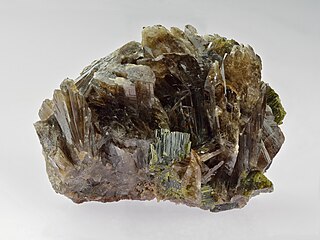
Axinite is a brown to violet-brown, or reddish-brown bladed group of minerals composed of calcium aluminium boro-silicate, (Ca,Fe,Mn)3Al2BO3Si4O12OH. Axinite is pyroelectric and piezoelectric.
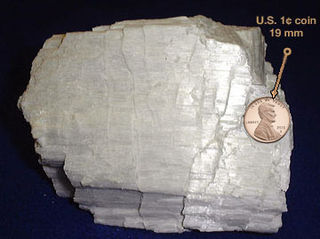
Wollastonite is a calcium inosilicate mineral (CaSiO3) that may contain small amounts of iron, magnesium, and manganese substituting for calcium. It is usually white. It forms when impure limestone or dolomite is subjected to high temperature and pressure, which sometimes occurs in the presence of silica-bearing fluids as in skarns or in contact with metamorphic rocks. Associated minerals include garnets, vesuvianite, diopside, tremolite, epidote, plagioclase feldspar, pyroxene and calcite. It is named after the English chemist and mineralogist William Hyde Wollaston (1766–1828).
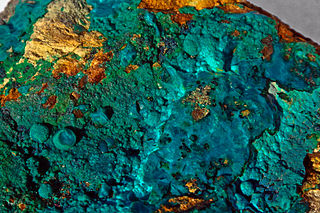
Silicate minerals are rock-forming minerals made up of silicate groups. They are the largest and most important class of minerals and make up approximately 90 percent of Earth's crust.

Braunite is a silicate mineral containing both di- and tri-valent manganese with the chemical formula: Mn2+Mn3+6[O8|SiO4]. Common impurities include iron, calcium, boron, barium, titanium, aluminium, and magnesium.
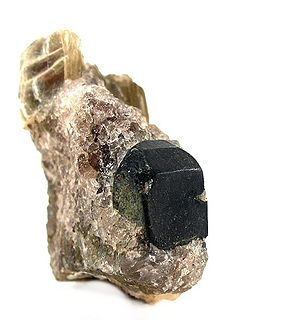
Triphylite is a lithium iron(II) phosphate mineral with the chemical formula LiFePO4. It is a member of the triphylite group and forms a complete solid solution series with the lithium manganese(II) phosphate, lithiophilite. Triphylite crystallizes in the orthorhombic crystal system. It rarely forms prismatic crystals and is more frequently found in hypidiomorphic rock. It is bluish- to greenish-gray in color, but upon alteration becomes brown to black.
Abswurmbachite (IMA symbol: Abs) is a copper manganese silicate mineral ((Cu,Mn2+)Mn3+6O8SiO4). It was first described in 1991 and named after Irmgard Abs-Wurmbach (born 1938), a German mineralogist. It crystallizes in the tetragonal system. Its Mohs scale rating is 6.5 and a specific gravity of 4.96. It has a metallic luster and its color is jet black, with light brown streaks.

Chloritoid is a silicate mineral of metamorphic origin. It is an iron magnesium manganese alumino-silicate hydroxide with formula (Fe, Mg, Mn)
2Al
4Si
2O
10(OH)
4. It occurs as greenish grey to black platy micaceous crystals and foliated masses. Its Mohs hardness is 6.5, unusually high for a platy mineral, and it has a specific gravity of 3.52 to 3.57. It typically occurs in phyllites, schists and marbles.

Zakharovite is a mineral, a silicate of sodium and manganese; formula Na4Mn5Si10O24(OH)6·6H2O. It has a yellow colour with a pearly lustre. Discovered in 1982 in the Kola peninsula of Northern Russia, it is named after Evgeny Evgenevich Zakharov (1902–1980), the director of the Moscow Institute of Geological Exploration.

Neptunite is a silicate mineral with the formula KNa2Li(Fe2+, Mn2+)2Ti2Si8O24. With increasing manganese it forms a series with mangan-neptunite. Watatsumiite is the variety with vanadium replacing the titanium in the formula.
Almarudite (IMA symbol: Alr) is an extremely rare alkaline manganese beryllium silicate mineral of the cyclosilicates (ring silicates) class, with formula written as K([],Na)2(Mn2+,Fe2+,Mg)2(Be,Al)3[Si12O30], from the volcanic environment of the Eifel Mountains, Germany.

Nambulite is a lithium bearing manganese silicate mineral with the chemical formula (Li,Na)Mn
4Si
5O
14(OH). It is named after the mineralogist, Matsuo Nambu (born 1917) of Tohoko University, Japan, who is known for his research in manganese minerals. The mineral was first discovered in the Funakozawa Mine of northeastern Japan, a metasedimentary manganese ore.

Kanoite is a light pinkish brown silicate mineral that is found in metamorphic rocks. It is an inosilicate and has a chemical formula of (Mg,Mn2+)
2Si
2O
6. It is a member of pyroxene group and clinopyroxene subgroup.
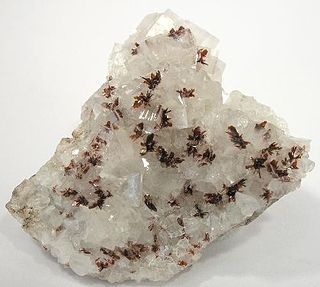
Ruizite is a sorosilicate mineral with formula Ca2Mn2Si4O11(OH)4·2H2O. It was discovered at the Christmas mine in Christmas, Arizona, and described in 1977. The mineral is named for discoverer Joe Ana Ruiz.

Brokenhillite (German: Brokenhillit Spanish: Brokenhillita) is a rare mineral that is only found in the far-western regions of New South Wales in Broken Hill, Australia. Although it has been given a name and chemical formula, it has not been approved by the International Mineralogy Association primarily because it is a manganese silicate of the pyrosmalite group which means the compositional similarities are too great to be an approved mineral. Brokenhillite structure is either composed of iron or manganese with the formula (Mn+2, Fe+2)8Si6O15(OH,Cl)10. The actual components inside brokenhillite can be determined using a diffractometer. The structural basis of this mineral is determined to be phyllosilicate within the pyrosmalites due to the octahedral structure, with one perfect cleavage, a hardness of about 4.5, and a streak of light brown.
Carbokentbrooksite is a very rare mineral of the eudialyte group, with formula (Na,[])12(Na,Ce)3Ca6Mn3Zr3NbSiO(Si9O27)2(Si3O9)2(OH)3(CO3).H2O. The original formula was extended to show the presence of cyclic silicate groups and silicon at the M4 site, according to the nomenclature of eudialyte group. Carbokenbrooksite characterizes in being carbonate-rich (the other eudialyte-group species with essential carbonate are zirsilite-(Ce), golyshevite, and mogovidite). It is also sodium rich, being sodium equivalent of zirsilite-(Ce), with which it is intimately associated.
Yangite (PbMnSi3O8•H2O) is a chain-silicate mineral, first discovered within the Kombat mine in Namibia. The mineral is named after Hexiong Yang, a researcher within University of Arizona's Department of Geosciences. Yangite was approved as a valid mineral species by the International Mineralogical Association in 2012.